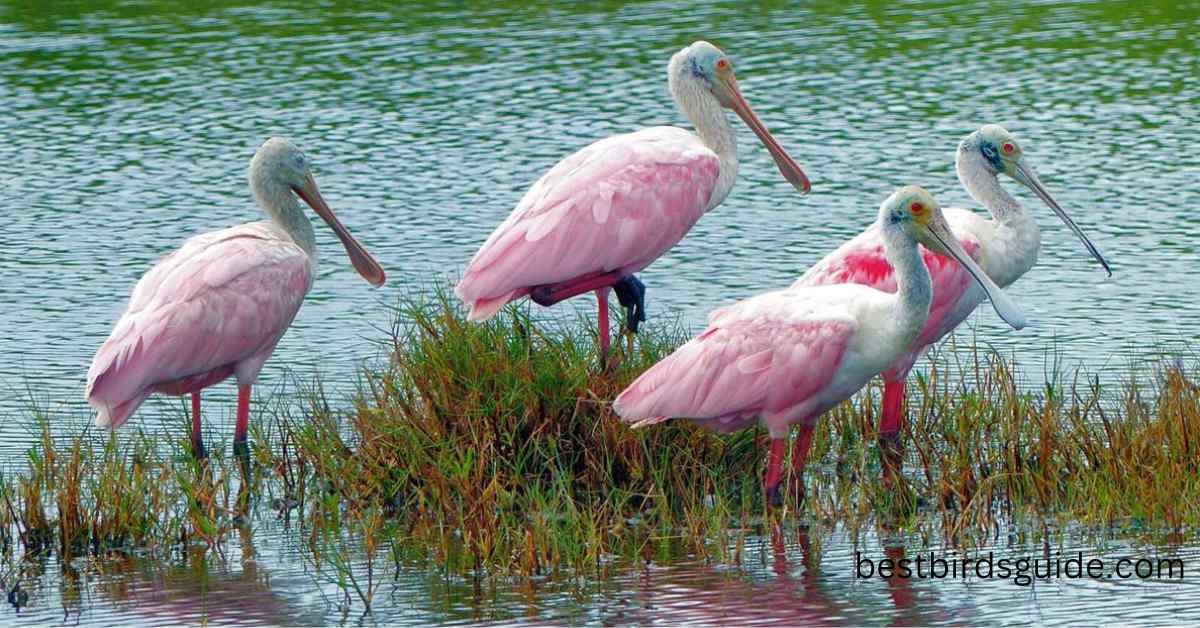Flamingos are one of the most recognizable birds in the world, with their bright pink feathers and long legs. But did you know that several other bird species look similar to flamingos? It can be challenging to tell them apart, so we’ve created a list of 10 birds that look like flamingos to help you distinguish between them. With this guide, you’ll always get them clear!
10 Birds That Look Like Flamingos
Birds of a feather flock together, but not when it comes to flamingos. Flamingos are a unique and beautiful species that stand out among other birds due to their specific physical features. However, some birds share similar characteristics with flamingos. To celebrate the iconic beauty of these birds, here is a list of 10 birds that look like flamingos:
Great Egret

The Great Egret (Ardea alba) is a majestic wading bird species native to much of the world. They are large egrets with a wingspan reaching more than three feet, and black bills, legs, and feet accent their white plumage. The Great Egret’s long neck gives them an elegant grace as they hunt for fish in shallow waters or soft-bodied invertebrates such as frogs and salamanders.
Great Egrets are found in wetlands, marshes, estuaries, rivers, and even puddles around the world in temperate regions from North America through Europe to Indonesia. In addition to its graceful beauty, it has also been associated with luck since ancient times. It was believed that they brought good fortune to anyone who saw them before undertaking an important task or journey.
Roseate Spoonbill

The Roseate Spoonbill (Plataleaajaja) is a graceful wading bird native to the southeastern United States, Central and South America, and the Caribbean. Its brilliant pink plumage and distinctive spoon-shaped bill make it one of the most recognizable birds in these regions. Spoonbills feed mainly on small aquatic animals such as crustaceans, mollusks, and insects.
Spoonbills form large breeding colonies in freshwater wetlands, salt marshes, mangrove swamps, and lagoons. They often nest in trees or shrubs near shallow water where they can easily feed. The males perform elaborate courtship displays involving arching their wings over their backs while striding back and forth to gain the attention of potential mates.
Sandhill Crane-Birds That Look Like Flamingos

The sandhill crane has become a beloved bird in wetlands across the country. This majestic bird is known for its striking presence, standing up to four feet tall with a wingspan that can reach up to seven feet. The sandhill crane is also recognizable by its loud, bugling call, which can be heard several miles away.
Sandhill cranes are found in wet meadows, marshes, and open grasslands, where they feed on insects, worms, grain, and other vegetation types. During breeding, they will choose a mate and nest in late spring or early summer. They build their nests on the ground out of sticks and grass near shallow water sources to easily access food sources during their fledging period.
Painted Stork

The painted stork is a large, graceful wetland bird species inhabiting wetlands across South and Southeast Asia. Originating from India and Sri Lanka, these impressive birds are the birds that look like flamingos by their distinctive white feathers with pinkish-red patches along the wings and neck.
Painted storks rely on wetlands for breeding grounds and food sources like small fish, amphibians, insects, reptiles, and crustaceans.
They typically breed in colonies near shallow waters where they can find ample food sources. Breeding season usually takes place between January to April when an abundance of prey is available to sustain large populations of painted storks at once. During this time, they also built nests made from reeds and sticks, placed high up in trees or on the ground near water bodies.
Scarlet Ibis

The Scarlet Ibis is a beautiful and graceful bird found in coastal regions of South America. It has a striking red body with a black head, neck, and bill, making it one of the most recognizable bird species on the continent. The Scarlet Ibis is not just an aesthetically pleasing animal but also plays an essential role in its ecology as it helps to keep track of insect populations in the area.
Their diet consists mainly of insects and spiders that live among the marsh grasses near their habitat. They also eat small fish, shrimp, mollusks, worms, and other aquatic invertebrates, as well as small fruits or berries when they can find them. During mating season, males display their bright plumage to attract potential mates, while females build nests near water sources for nesting and raising young birds.
Siberian Crane

The Siberian Crane is a majestic bird with a long history. Native to East Asia and the Russian Far East, this crane species has been revered for centuries for its beauty and grace. The species is currently in danger of extinction due to numerous factors, such as habitat loss, hunting, and diminishing food sources.
They can stand up to four feet tall and has white feathers with black wing tips. These birds have mighty wings that allow them to fly great distances each year when migrating from their breeding grounds in Siberia to their wintering sites in China or northern India. They are omnivorous feeders, consuming fruit, insects, small animals, and even fish during their migratory journey.
Capped Heron

The Capped Heron is a large wading bird native to the tropical forests of South America. This species is known for its bright yellow cap, which contrasts strikingly with its otherwise grey-brown plumage. It stands at an impressive size of between 25–32 inches tall and can be easily identified while wading in shallow waters.
Capped Herons inhabit marshes, swamps, lagoons, and other wetland areas in Colombia, Venezuela, Peru, and Brazil. They feed primarily on small fish but may also consume aquatic insects, crustaceans, and small amphibians such as frogs. The Capped Heron will often hunt by standing still in the water, waiting for prey to come within reach before striking quickly with its bill.
White Stork

The white stork is an impressive species of bird that has long captivated people’s imaginations worldwide. These large migratory birds are known for their striking white plumage and red beaks and tendency to nest on top of buildings and chimneys. Native to Europe, North Africa, and western Asia, the white stork is a symbol of good luck in many cultures, with some believing that it brings babies to households.
They stand 1 meter tall on average and can weigh up to 4 kilograms. They feed primarily on insects, amphibians, reptiles, small mammals, and fish which they find while scanning open ground or wetlands with their eyesight. The breeding season begins in April when pairs build their nests out of sticks and twigs high up on rooftops or other tall structures such as trees or utility poles.
Great Blue Heron

The Great Blue Heron are majestic birds that look like flamingos. With its long legs and neck, it stands tall and proud as it surveys its surroundings for potential prey. This species of Heron can be seen in wetlands, marshes, ponds, rivers, and even along coastal areas. Its size ranges from 3-4 feet tall, with a wingspan of up to 6 feet.
This regal-looking bird is easily identifiable by its slate blue feathers that are highlighted with white stripes on either side of the head and chest.
They feed mainly on fish but eat amphibians, crustaceans, or other small animals they can catch in the water or near the shoreline. It uses its sharp bill to stab at prey before swallowing them whole, along with some water to help digest their meal faster.
Whooping Crane- birds that look like flamingos

The whooping crane is one of the most threatened species of birds in North America. This large, iconic bird has a long history and is an important symbol for conservation efforts. Whooping cranes are unique among birds due to their white feathers, red crowns, black wingtips, and loud call that can be heard from up to two miles away.
These incredible creatures inhabit wetlands across North America, including Texas and Canada but are threatened by habitat loss, collisions with power lines, and other human disturbances.
Whooping crane populations had declined since the mid-1800s when they were hunted for food and feathers to adorn hats. By 1941, only 15 individuals remained in the wild, leading to intense conservation efforts from multiple groups over the past decades.
Types of Flamingo
The Flamingo is a beautiful bird that comes in wide varieties. Six species of Flamingo have been identified, each with its unique characteristics and habitat.
- American (Caribbean) Flamingo can be found in large colonies throughout Northern South America, including the Caribbean. This species is distinguished by its bright pink feathers and long legs.
- Andean Flamingo inhabits high-altitude wetlands in the Andes Mountains from Peru to Argentina. It has slightly darker feathers than other species of flamingos due to its diet of algae and brine shrimp found at higher elevations.
- The Chilean Flamingo is native to South America’s coastal regions, including Chile and Argentina. They are notable for their white or pale pink feathers, distinguishing them from other flamingos.
- Greater Flamingo is the most commonly seen type of Flamingo, with its bright pink plumage and large size making it recognizable to many people. This species is found in Africa, Europe, Asia, India, and the Middle East.
- Lesser Flamingo is smaller than its larger relative but stands at an impressive height of around 40 inches. This species has a paler pink coloration on its feathers and is more commonly seen living in alkaline lakes rather than coastal areas like the Greater Flamingo.
- James S Flamingo has a unique curved bill with black edges which it uses to strain its food from the water or mudflats. It has pinkish-orange feathers, with white markings on its wings that become more vivid during the breeding season. These birds also have long legs, which help them wade through shallow water in search of food such as shrimp, algae, mollusks, insects, and other small aquatic creatures.
Types of Pink Birds
When thinking of birds, many think of the bright and distinct colors they come in. One color that stands out among them is pink. Pink birds are a vibrant sight to behold, making them popular among bird watchers and pet owners. Many different types of pink birds can be found worldwide, each with unique characteristics. From pink flamingos to beautiful rose-colored hummingbirds, these vibrant feathered creatures fascinate any bystander who sees them.
The most recognizable species of pink bird is likely the American Flamingo, primarily found in southern Florida and the Caribbean islands. These large wading birds have long legs that help them navigate through shallow waters, searching for food like crustaceans and insects.
Conclusions
these birds are not flamingos but are closely related to the drongo family of birds. They may have similar coloration and be able to stand on one leg, but they are not related to the true flamingos. While these birds may look like flamingos, it’s important to remember that they are not associated with them. So next time you see birds that look like flamingos, don’t be fooled!
READ MORE Pink Birds in Florida-3 Incredible Types

